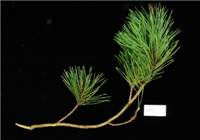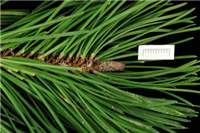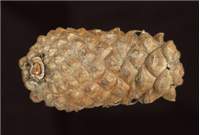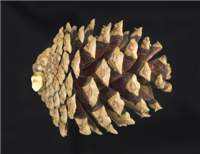Name
Pinus contorta Douglas ex Loudon, Arbor. Frutic. Brit. 4: 2292 (1838).[Lodgepole pine, Contorta pine]
Description
Habit: Varies from a shrub to a large tree at least 35 m tall when mature.
Bark: In young trees thin and smooth. In old trees varies from thick, roughly fissured, and deeply divided into small regular plates, to scaly with fine curled flakes. Colour varies from reddish brown to pinkish grey.
Foliage: Needles in 2ís, usually 2.5-6.5 cm long, 0.9-2.5 mm wide; yellowish green to dark green; rigid with a short horny point, often twisted; densely set and forward pointing. Leaf sheath persistent; 4-7 mm long on young needles reducing to 2-4 mm on older needles.
Branchlets: Green to orange-green at first, becoming brown to grey-brown in the second year, without hairs, shiny, moderately stout, and ridged. Leaf bract bases persistent.
Winter buds: Usually cylindrical and short-pointed, occasionally ovoid; purplish or red-brown, often with a whitish coating of resin and closely pressed bud scales. Buds may be only slightly resinous with some free bud scale tips.
Cones: Often present from an early age; solitary, or in pairs, occasionally whorled; shortly stalked to subsessile; generally persistent, and in the inland subspecies often not opening until several years after maturity; ovoid to sub-cylindrical or conical, sometimes with asymmetrical base. 2-6 cm long, 1.5-2.5 cm wide when closed and up to 3.5 cm open. Shiny yellowish brown to bright coppery brown when young, becoming lighter brown, weathering to grey-brown. Scales thin with a transversely ridged grey umbo terminating in a slender, occasionally deciduous, prickle 2-3 mm long.
Seeds: Small, 3-5 mm long, 2-2.5 mm wide; dull, very dark grey-brown to almost black, sometimes yellowish to reddish brown with rough surface of black mottling, angular, pointed. Wing 7-15 mm long, pale brown to brown, often with streaks of dark brown.
Notes
A number of varieties have been described, of which P. contorta Douglas ex Loudon var. contorta and P. contorta Douglas ex Loudon var. latifolia Engelm. have been planted in NZ. Lodgepole pine can be distinguished from most other two needled pines by its bark, which is divided into small irregular plates or scales; by its short needles (less than 9 cm), and its persistent small prickly cones (less than 6 cm long). Pinus contorta is closely related to and readily hybridises with P. banksiana but the latter is easily distinguished by the bent or kinked cones. Pinus contorta is similar to P. uncinata but the cones of P. uncinata are distinctive with long recurved umbos on the basal scales.
Natural Distribution
Mexico, W U.S.A. to W Canada.



